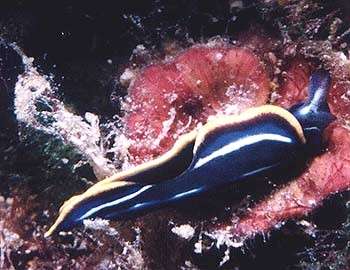
Thuridilla hopei
(Verany, 1853)
Order: SACOGLOSSA
Superfamily: ELYSIOIDEA
Family: Elysiidae
PHOTO
Costa Brava, Spain.
UPPER RIGHT: 15m, Photo: Miquel Pontes
LOWER LEFT: 8m, Photo: Albert Ollé
LOWER RIGHT: 6m, Photo: Lluís Aguilar
Pictures were shot at 15m, 8m and 6m, always on rocky bottoms where the green algae Cladophora grows.
References:
• Verany, M. (1853). Catalogue des Mollusques cephalopodes, pteropodes, Gasteropodes nudibranches, etc.... des environs de Nice. Journal de Conchyliologie, 4(1): 375-392
• Gascoigne, T. (1985) A provisional classification of families of the order Ascoglossa (Gastropoda: Nudibranchiata). Journal of Molluscan Studies, 51: 8-22
• Jensen, K.R. (1992) Anatomy of some Indo-Pacific Elysiidae (Opisthobranchia: Sacoglossa (=Ascoglossa)), with a discussion of the generic division and phylogeny. Journal of Molluscan Studies, 58: 257-296
• Thompson, T.E. & Salghetti-Drioli, U. (1984) Unusual features of the development of the sacoglossan Elysia hopei in the Mediterranean Sea. Journal of Molluscan Studies, 50: 61-63
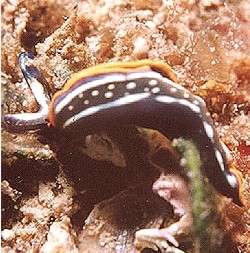
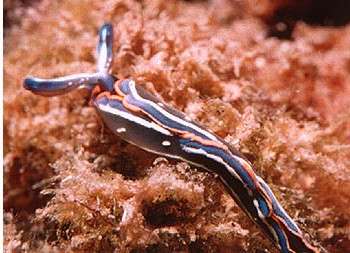
Rudman, W.B., 2000 (January 28) Thuridilla hopei (Verany, 1853). [In] Sea Slug Forum. Australian Museum, Sydney. Available from http://www.seaslugforum.net/find/thurhope
Related messages
Re: Thuridilla hopei under predation attack
June 12, 2009
From: Dominique Horst
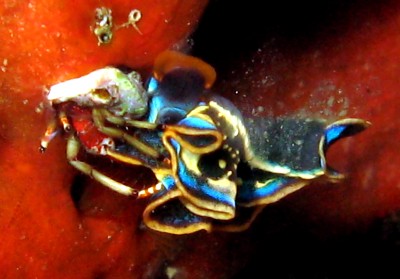
Hi Bill,
Not sure if this kind of sequence is not out of subject on the forum, but it is not so frequent and I can't resist of sharing this predation attack from Calcinus tubularis on Thuridilla hopei.
I can't say whether the Thuridilla was released in the end.
Locality: Villefranche sur mer, 5 m, France, Mediterranean sea, 31 May 2009. Length: 20 mm. Photographer: Elisabeth Juan.
Kind regards,
Dominique
dominique.horst@wanadoo.fr
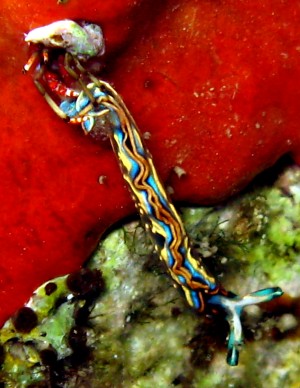
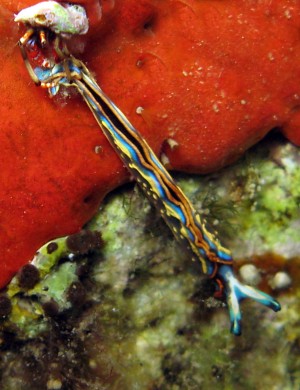
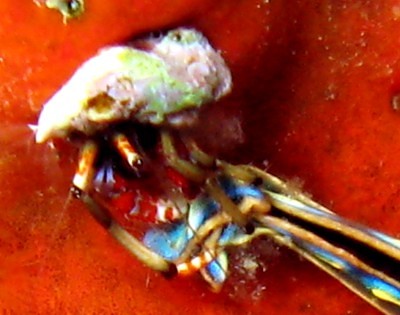
Dear Dom,
This is an excellent topic for the Forum and fits well with the on-going discussion on damage to Discodoris atromaculata [see message #22521].
For those of you unfamilar with crustacea, Calcinus tubularis is a common hermit crab in European waters. From Elisabeth Juan's photos the crab is not making much effort to let go.
Best wishes,
Bill Rudman
Thuridilla hopei from the French Mediterranean
April 9, 2008
From: Dominique Horst
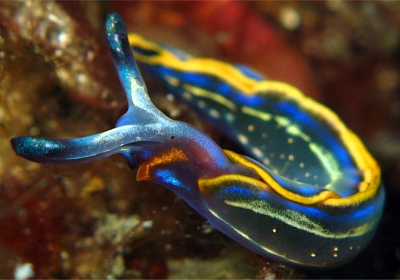
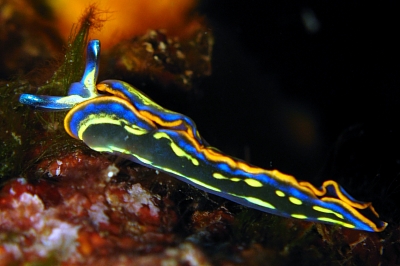
Hello Bill,
With the last shot of my buddy, we can realize the great variability in colours of Thuridilla hopei.
Locality: Antibes Cape, 20 m, France, Mediterranean sea, 15 October 2007. Length: 15 mm. Photographer: Dominique Horst (photos 1-2) & Eric Poisson (photo 3).
Many thanks and kind regards,
Dom.
dominique.horst@wanadoo.fr
Horst, D., 2008 (Apr 9) Thuridilla hopei from the French Mediterranean. [Message in] Sea Slug Forum. Australian Museum, Sydney. Available from http://www.seaslugforum.net/find/21023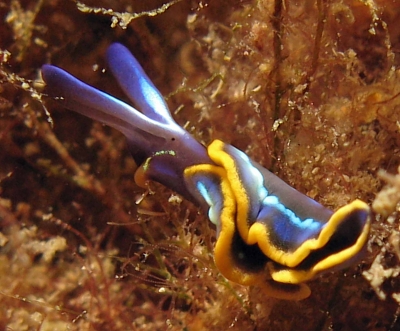
Thanks Dom,
The photos certainly show some of the variation. Looking at Eric's photo I would think that animal is a juvenile? When compared with the animals in the upper two photos, the rhinophores [head tentacles] are much larger in proportion to the body size. Juvenile sea slugs often have greatly enlarged rhinophores - perhaps emphasising the importance of the sense of smell in the lives of these animals.
Best wishes,
Bill Rudman
Thuridilla hopei from Israel
July 2, 2007
From: Dani Barchana
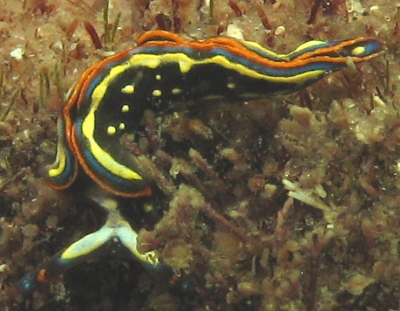
Concerning message #17707:
My friends Michael Levin (www.pbase.com/manta_ray) and Benjamin Koretz (www.koretz.net/ ) have identified this one for me as Thuridilla hopei. I have not seen any mention to it from our area of the Mediterranean sea, so I add my sighting.
Locality: Michmort beach, 2 meters, Israel, Mediterranean Sea, 16 June 2007, Rockery. Length: 1.5-2 cm. Photographer: Dr. Dani Barchana.
Dani Barchana
dani.barchana@gmail.com
Barchana, D., 2007 (Jul 2) Thuridilla hopei from Israel. [Message in] Sea Slug Forum. Australian Museum, Sydney. Available from http://www.seaslugforum.net/find/20048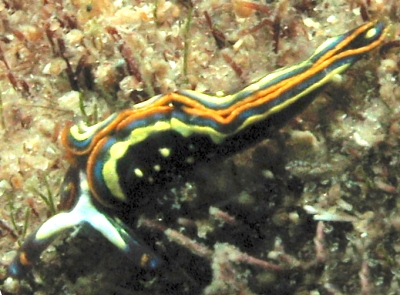
Thanks Dani,
Bill Rudman
Rudman, W.B., 2007 (Jul 2). Comment on Thuridilla hopei from Israel by Dani Barchana. [Message in] Sea Slug Forum. Australian Museum, Sydney. Available from http://www.seaslugforum.net/find/20048Thuridilla hopei from Turkey
September 4, 2006
From: Kerim Sabuncuoglu
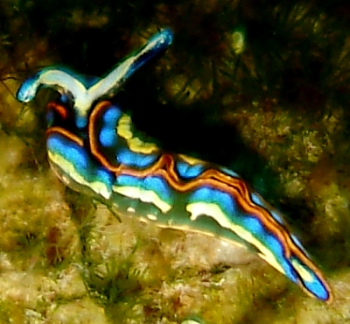
I took this photo in Bodrum - Turkey at a depth of 15 m. The slug is 0.5 cm long. This is not a common slug to our waters so I wonder if it is a new spicies.
Locality: Bodrum , 15 m, Turkey, Aegean Sea, 9 aug. 2006, Rocks. Length: 5 mm. Photographer: Kerim Sabuncuoglu.
Unfortunately I did not have my master camera and housing so this one was taken with a point and shoot digital camera.
Best Regards
Kerim Sabuncuoglu
ksabuncu@gmail.com
Sabuncuoglu, K., 2006 (Sep 4) Thuridilla hopei from Turkey. [Message in] Sea Slug Forum. Australian Museum, Sydney. Available from http://www.seaslugforum.net/find/17707Dear Kerim,
This colourful elysiid sacoglossan, Thuridilla hopei, is very variable in colour. By chance, the last message we received on this species, from Vasilis Athanasopoulos, was of a similarly coloured animal from Greece [#15307]. Best wishes,
Bill Rudman
Re: Variation in Thuridilla hopei
November 22, 2005
From: Vasilis Athanasopoulos
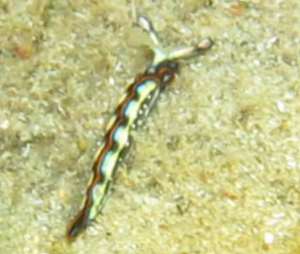
Hi,
I have observed this common colour variant of Thuridilla hopei but in very shallow water in west Greece. The photo was taken in Sept 2005 north-west Peloponeese, at less than 30cm depth, on a rock covered with algae. There were at least 6 of these on the same rock. Lenghts: 0.8-2cm.
Locality: Kounoupeli beach, Ileia, Greece. Mediterranean. Depth: 0.3 metres. Length: 0.8-2 cm. September 2005. rock covered with algae. Photographer: Vasilis Athanasopoulos
Vasilis
biotechmail@gmail.com
Athanasopoulos, V., 2005 (Nov 22) Re: Variation in Thuridilla hopei. [Message in] Sea Slug Forum. Australian Museum, Sydney. Available from http://www.seaslugforum.net/find/15307Thanks Vasilis,
When I see the enormous range of colour variation in this Mediterranean species it makes me wonder if we should be expecting similar variability in some of the Indo-West Pacific species.
Best wishes,
Bill Rudman
Thuridilla hopei: nice mating behaviour
September 14, 2005
From: Marina Poddubetskaia Ossokine
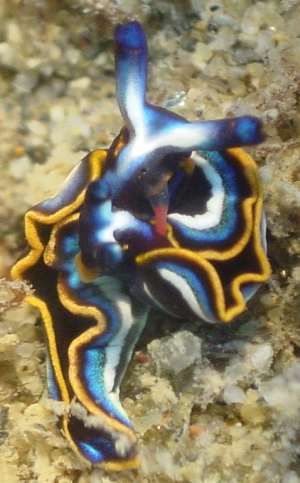
Dear Bill,
I have seen many opisthobranchs mating, but these 2 Thuridilla hopei seems particularly romantic, embraced lovely like this. I saw these animals coming to each other, 'embracing', mating and separating in less than 5 minutes. They are quite a quick 'lovers' :-)
Locality: 'La digue', Port-Leucate, France. Mediterranean. Depth: 2 m. Length: 9 mm. 12 September 2005. Photographer: Marina Poddubetskaia Ossokine
Also, in one photo the penis is well visible. So maybe, these photos could be valuable for the Forum.
Best wishes,
Marina.
Nembro website
nembro@nembro.info
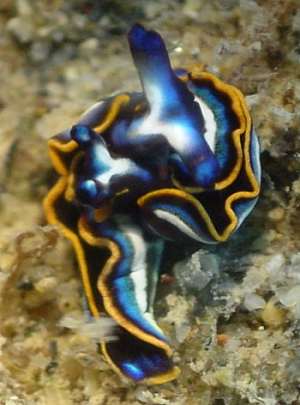
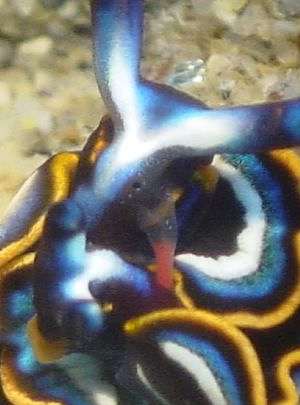
Dear Marina,
Thanks for these photos. I am always interested in photos illustrating aspects of sea slugs' biology. Mating in sacoglossans is quite interesting because many of them practice hypodermic impregnation in which a spine at the tip of the penis is used to pierce a hole in the body wall and sperm is injected directly into the body cavity, A temporary sac is rapidly formed to contain the sperm. From a quick reading of the literature, I am pretty sure no species of Thuridilla exhibits this behaviour, altrhough some species of Elysia do.
One thing that does puzzle me is that all species of Thuridilla seem to have a sperm sac for receiving incoming sperm [bursa copulatrix] which has its own separate external opening, but no internal connection to the rest of the reproductive system. I wonder how sperm gets from the sac to fertilise the eggs? We still have a lot to learn.
Best wishes,
Bill Rudman
Thuridilla hopei - mating observations
November 22, 2002
From: Nils Anthes
Dear Bill,
I am a PhD student in Evolutionary Biology, University of Muenster, Germany. My main interest is in mating conflicts in hermaphrodites, using hermaphroditic sea slugs as a model system. For mating experiments, we collected about 120 Thuridilla hopei from 2-8 m depths near Calvi, Corsica in early October 2002. As we only made lab observations, we are curious about any report of persons who have witnessed matings in the field (besides Andreas Ahrens' observation).
In contrast to the suggestion made by Erwin Koehler, we found colouration to be extremely variable even in these shallow waters. Specimens as dark as the one described by Erwin Koehler from 57 m depth were present as well as very pale slugs (very pale orange and yellow bars). The slugs did not mate very often, but we confirmed matings even in very small animals(about 6mm length) and with partners which were about twice their own size (= length). The largest animal we found was about 29mm total length (excluding rhinophores), which is larger than others mentioned in literature.
Best wishes
Nils Anthes
anthes@uni-muenster.de
Anthes, N., 2002 (Nov 22) Thuridilla hopei - mating observations. [Message in] Sea Slug Forum. Australian Museum, Sydney. Available from http://www.seaslugforum.net/find/8454Thanks Nils,
Bill Rudman
Re: Mating Thuridilla hopei
August 1, 2002
From: Kathe R. Jensen
Dear Bill and Andreas,
Concerning your discussion - Development in Thuridilla hopei has been described by Thompson & Salghetti-Drioli (1984). It has lecithotrophic development, and both eggs and extra-capsular yolk is red at first, the colour of the eggs fading as embryological development progresses. Copulation has been described by Gascoigne (1985).
All species of Thuridilla for which egg masses have been described, have red or orange eggs, and most have extra-capsular yolk of the same colour (Jensen, 1992).
References:
• Gascoigne, T. (1985) A provisional classification of families of the order Ascoglossa (Gastropoda: Nudibranchiata). Journal of Molluscan Studies, 51: 8-22.
• Jensen, K.R. (1992) Anatomy of some Indo-Pacific Elysiidae (Opisthobranchia: Sacoglossa (=Ascoglossa)), with a discussion of the generic division and phylogeny. Journal of Molluscan Studies, 58: 257-296.
• Thompson, T.E. & Salghetti-Drioli, U. (1984) Unusual features of the development of the sacoglossan Elysia hopei in the Mediterranean Sea. Journal of Molluscan Studies, 50: 61-63.
Best wishes,
Kathe
jensen@ait.ac.th
Jensen, K.R., 2002 (Aug 1) Re: Mating Thuridilla hopei. [Message in] Sea Slug Forum. Australian Museum, Sydney. Available from http://www.seaslugforum.net/find/7677Thanks Kathe,
Bill Rudman
Thuridilla hopei from French Mediterranean
July 30, 2002
From: Marina Poddubetskaia
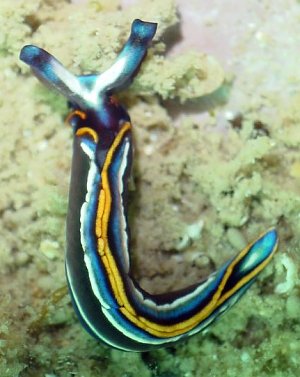
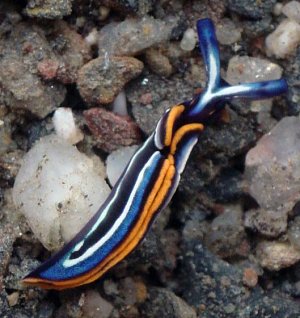
Dear Bill,
Here are some photos of Thuridilla hopei, more coloured than last time :-) and with another colour pattern.
Upper Photo:
Date: July 02, 2002
Location: Cerbere, France
Site: L'Ocell
Depth: 14m
Size: 3-4cm
Lower Photo: juvenile ?
Date: July 01, 2002
Location: Cerbere, France
Site: Les 3 moines
Size: 12-13mm
Photos: Marina Poddubetskaia - Nembro website
Best wishes,
Marina.
nembro@nembro.info
Poddubetskaia, M., 2002 (Jul 30) Thuridilla hopei from French Mediterranean. [Message in] Sea Slug Forum. Australian Museum, Sydney. Available from http://www.seaslugforum.net/find/7551Thanks Marina,
Bill Rudman
Re: Mating Thuridilla hopei from Croatia
July 30, 2002
From: Andreas Ahrens
Hello Bill,
Concerning your comment. Unfortunately I know nothing about embryological development of Thuridilla hopei. But I checked all my photos of Thuridilla hopei. The front of the foot is seldom visible but it always has this red colour, not only when mating.
The red colour that so many sea animals show always was a bit mysterious to me. Since the sunlight is filtered selectively by the water in a depth of five meters there is not red any more. So, anything that "is red" appears black. At least as long as there is no curious diver with an artficial light source.
Ciao,
Andreas
Andreas.Ahrens@hamburg.de
Ahrens, A., 2002 (Jul 30) Re: Mating Thuridilla hopei from Croatia. [Message in] Sea Slug Forum. Australian Museum, Sydney. Available from http://www.seaslugforum.net/find/7654Thanks Andreas,
I wasn't expecting an answer from you. My question was more in the way of 'thinking aloud'. You are right to bring up the question of colour. It's not only a question of how we see different colours at different depths but how other animals, such as fish, 'see' colours. A very fascinating area for research.
Best wishes,
Bill Rudman
Mating Thuridilla hopei from Croatia
July 21, 2002
From: Andreas Ahrens
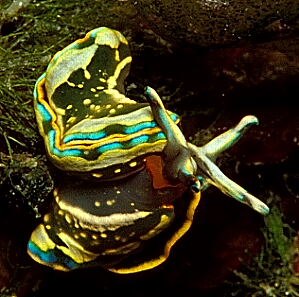
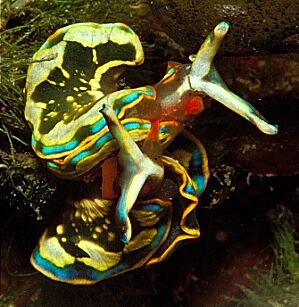
Dear Bill,
I took these photos of mating Thuridilla hopei in the Bay of Split (Croatia, Adriatic Sea, June 07, 2001, depth: 5m). May be they yield some useful information to anyone.
Andreas
Andreas.Ahrens@hamburg.de
Ahrens, A., 2002 (Jul 21) Mating Thuridilla hopei from Croatia. [Message in] Sea Slug Forum. Australian Museum, Sydney. Available from http://www.seaslugforum.net/find/7541Thanks Andreas,
I can't say I have seen a sacoglossan with a bright red penis before. I wonder what the point of that is? I note the front of the foot is also red, perhaps the penis originates from the foot in embryological development?
Best wishes,
Bill Rudman
Thuridilla hopei? from Croatia
June 26, 2002
From: Andreas Ahrens
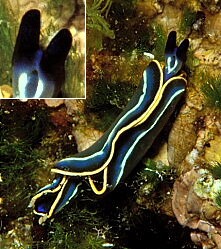
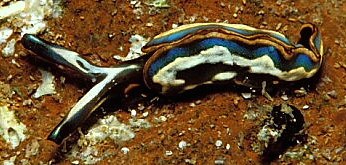
Hello Bill!
In the bay of Split (Croatia, Adriatic Sea, June 07, 2001) I took this photo of a slug that looks like the upper right photo in Miquel Pontes' message about Thuridilla hopei. The shape of the body is typical for the family Elysiidae, but the rhinophores are completely different (see close-up): they are much smaller and round without sharp edges. For comparison I included a photo of a typical Thuridilla hopei (blue variant, juvenile) from the same region. Is Thuridilla hopei really able to change the form of it's rhinophores so drastically or is this another species?
Andreas
Andreas.Ahrens@hamburg.de
Ahrens, A., 2002 (Jun 26) Thuridilla hopei? from Croatia. [Message in] Sea Slug Forum. Australian Museum, Sydney. Available from http://www.seaslugforum.net/find/7347Dear Andreas,
The rhinophores do look a bit strange. If you look at Erwin Kohler's message, he has a photo [ek061905] from Croatia of an animal with almost the same colouration as yours but with longer, more normal, rhinophores. This species seems very variable in colour, but in all the photos on the Forum, except your animal, there is a white band running up the rhinophores. I suspect the absence of this in your animal suggests that it has been damaged - perhaps the rhinophores bitten off - and has regrown them as best it can, without the white band.
Best wishes,
Bill Rudman
Thuridilla hopei from French Mediterranean
June 25, 2002
From: Marina Poddubetskaia
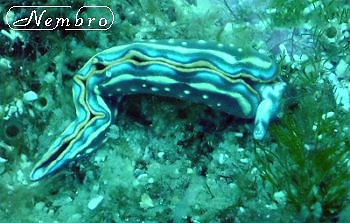
Dear Bill,
Here is a photo of Thuridilla hopei
Cap Croisette (near Marseille), France. Site: Pierre qui tramole., Depth: 15m, Size: about 3cm., June 04, 2002
Best wishes,
Marina.
www.nembro.info
nembro@nembro.info
Poddubetskaia, M., 2002 (Jun 25) Thuridilla hopei from French Mediterranean. [Message in] Sea Slug Forum. Australian Museum, Sydney. Available from http://www.seaslugforum.net/find/7304Thanks Marina,
Bill Rudman
Variation in Thuridilla hopei
February 20, 2000
From: Erwin Koehler
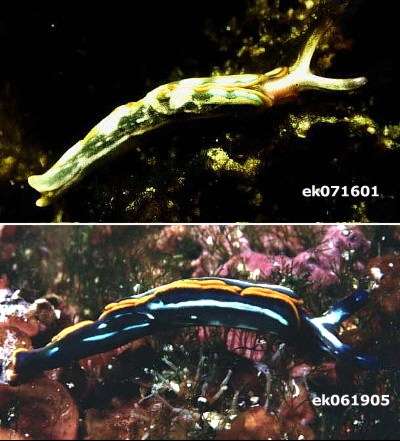
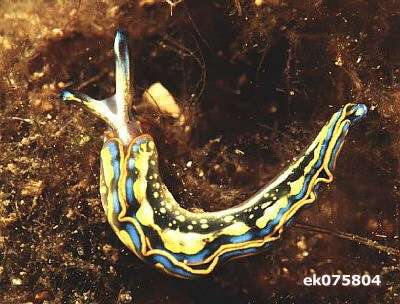
Hi Bill,
here are some more colour variants of Thuridilla hopei (Vérany, 1853) from the Mediterranean.
My impression is, that the very dark blue form with no yellow spots, or very few, and dark orange/red lines at the edge of the parapodia live rather deep. For example the upper right specimen in Miquel Pontes message was at 15 m, my EK061905 was taken at 57 m depth in Croatia, Balun Is., July 1996 - length 2,5 cm.
In shallow waters the variant like EK075804 is very common - this one was taken in Italy, Elba Is., Capoliveri, divesite "Yellow Wall" size 2 cm, depth 11m, July 07, 1997. It would be great to hear, if other divers and/or scientists made the same or other observations...
The greenish variant (EK071601) is from Malta, divesite "Blue Grotto", 12 mm, depth 6 m, May 08, 1997 - the only sight of this variant.
Erwin.
Medslugs.Koehler@t-online.de
Koehler, E., 2000 (Feb 20) Variation in Thuridilla hopei. [Message in] Sea Slug Forum. Australian Museum, Sydney. Available from http://www.seaslugforum.net/find/1934Dear Erwin,
Thanks for the observations. It will be interesting to hear what others have to say.
Best wishes,
Bill Rudman.
Any information on Thuridilla hopei?
January 31, 2000
From: Miquel Pontes

Here there are some pictures of some Thuridilla hopei we have come across in our dives in the Costa Brava (Spain).
Pictures were shot at 15m, 8m and 6m, always on rocky bottoms where Cladophora green algae grows. A common species yet endemic to the Mediterranean Sea.
Any information on this elysiid is welcome.
PHOTOS: Upper Right: Miquel Pontes; Lower Left: Albert Ollé; Lower Right: Lluís Aguilar.
Miquel Pontes
mpontes@marenostrum.org


